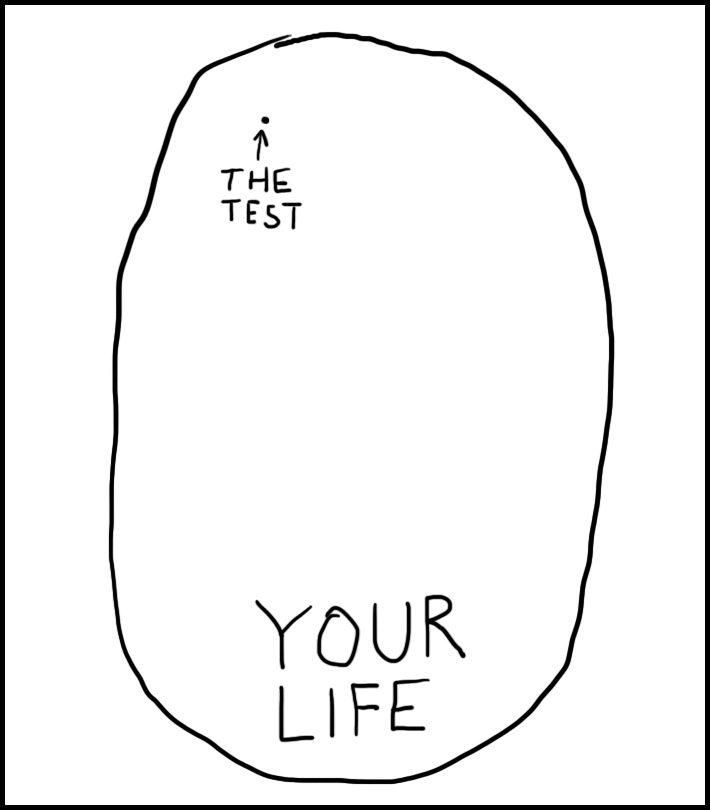What if a school principal told the truth about a test?
Because of the No Child Left Behind Law passed in 2002 our daughter and all of her classmates have spent the last couple of months preparing for tests that may (or may not) measure their intelligence and their ability to think critically.
Our daughter’s teachers have little idea what will be on the test. The test makers have given the schools very few details about what the questions will be or how they will be phrased. It’s something like training for a mystery Olympic event—on opening day you may be asked to pole vault, synchronize swim or run the 440.
The kids will sit their tables, taking these tests for 70 minutes a day for a total of six days.
By the way these kids are in third grade.
The origins of standardized testing date back to China over two thousand years ago with the Six Arts that included rites, music, archery, chariot racing, calligraphy and mathematics that foretold which boys would become gentlemen. Thomas Taylor Meadows, a British consul to China in the early 19th century, was taken with this idea and advocated for a similar testing concept in Britain. Meadows used a familiar pro-standardized testing argument, warning of a collapse of the British Empire if standardized testing was not implemented immediately throughout the empire. Britain acquiesced. Standardized testing became the norm.
To promote accountability the 2002 law No Child Left Behind mandated testing of kids’ reading and math skill in grades 3-8. Each state is directed to mete out sanctions and rewards, such as bonuses and recognition based on “student achievement.” No one is likely to grouse about the accountability—it’s the metrics that have people up in arms. Education department bureaucrats have the power to determine which test will be the measure of “student achievement,” and then how schools, teachers and students will be punished or rewarded based on those test scores.
Is the Common Core test an accurate metric for “student achievement?”
Is any test going to be an accurate metric for “student achievement?”
And even if the test accurately revealed “student achievement?” with so many rewards and punishments attached, will it distort how our kids are taught?
This year marks the second year that U.S. standardized tests are based on the Common Core. Last year’s test results were a shock to school administrators, teachers and parents nationwide. Students who met the standard plummeted from 70 to 3O percent.
The teachers at our daughter’s school want to accomplish two things that are somewhat at odds with each other. They try to ready the kids to do their best with days of preparation, but they also don’t want to put too much pressure on them. There is a lot of talk about getting enough sleep on the nights before test days, eating a good breakfast, listening to classical music and even accepting a Think Mint (offered by the teacher during the test) as a cue to relax.
On the day before the test the principal came into our daughter’s classroom and announced unequivocally, “I hate the test.” He even went so far as to say that he hated the test makers. (Not very p.c.!) That got the kids’ attention. In front of the class, the principal drew a large circle and said to the kids, “This is your life.” Within that circle he drew a tiny dot, saying, “And this is the test.”
This refreshing bit of candor and dose of realism got us thinking about how we as adults, too, can get caught up with the dots in our lives—formulaic tasks required by institutions. Think of the last time you had to put together a CV for an HR department, a mortgage application for a bank or a grant proposal for an art institute. By taking these tests we turn ourselves into metrics so that an organization can compare us against the metrics of other individuals. We can forget that we are not taking these tests for the organization but in order to advance our own goals. And because we are turned into metrics determined by someone else’s standards, for us these dots can loom as large and carry as much emotional weight as an arduous six-day test for a third grader.
Taking these tests can make you feel like life sucks. Taking them can make you feel like you are wasting your time. Sometimes we need someone like our daughter’s principal (or better yet, ourselves) to come along and remind us that even though we’ve invested more effort than we would have liked, these tests are mere specks in the wondrous wide circle of our lives.
Buy “The Art of Doing” here. Signup for “The Art of Doing” free weekly e-newsletter. Follow us on Twitter. Join “The Art of Doing” Facebook Community. If you’ve read “The Art of Doing” please take a moment to leave a review here.

